US Helps India Finance Solar
Air Date: Week of June 24, 2016
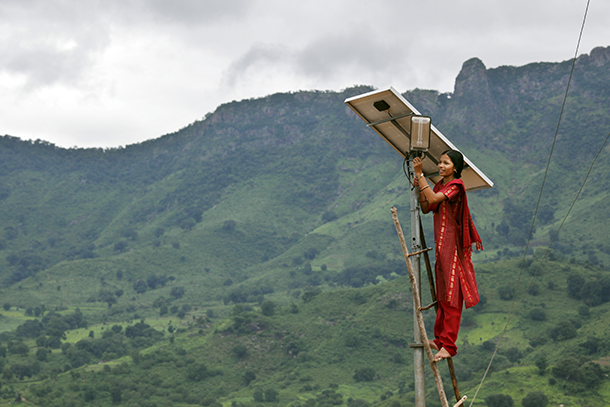
A woman maintains a solar panel in the village of Tinginaput, India, which is not connected to the main electricity grid (Photo: UK Department for International Development, CC BY-NC-ND 2.0)
Indian Prime Minister Narendra Modi and US President Barack Obama have announced a public and private financing package to leverage $1 billion in financing for solar power development in India. Renewable energy expert Carl Pope tells host Steve Curwood that financing is a major hurdle to growing carbon-free energy in the developing world, and that rich countries like the US need to help out if they want to slow the advance of climate change.
Transcript
CURWOOD: From the Jennifer and Ted Stanley studios at the University of Massachusetts Boston and PRI, this is Living on Earth. I’m Steve Curwood.
The Obama White House and a group of US foundations are joining forces to help India boost its efforts to go solar. The deal was announced recently when Indian Prime Minister Narendra Modi came to Washington and marks a milestone of cooperation between the world’s second and fourth biggest emitters of climate changing gases. Joining us to discuss the deal and Mr. Modi’s visit is Carl Pope, former executive director of the Sierra Club and now an advisor at Inside Straight Strategies. Welcome back to Living on Earth, Carl.
POPE: It’s wonderful to be with you again, Steve.
CURWOOD: So what exactly did President Obama and Prime Minister Modi agreed to here?
POPE: Well, they agreed to a couple of very important things, but what was most striking was that their joint clean energy agenda rose to the very top of the US-India relationship. The US-India relationship is under a bit of strain. There are a variety of topics on which the two countries don't agree, and one of the places they found that they can most easily and productively agree is on the transition from a carbon-based economy to a low-carbon economy, from dirty to clean, from outmoded to modern. And in that context, India asked the United States to prioritize its support for India's clean energy on India's greatest energy scandal and tragedy, which is that there are roughly two to four hundred million Indians who don't have access to electricity. These are mostly the poorest and most remotely located people in the country. They are in some cases, have a wire that runs to their village, so technically the village is electrified. It may have one light in the town square, but none of the houses have electricity, none of the families have lights, none of the families can charge cell phones, and this can be fixed and it can be fixed affordably.
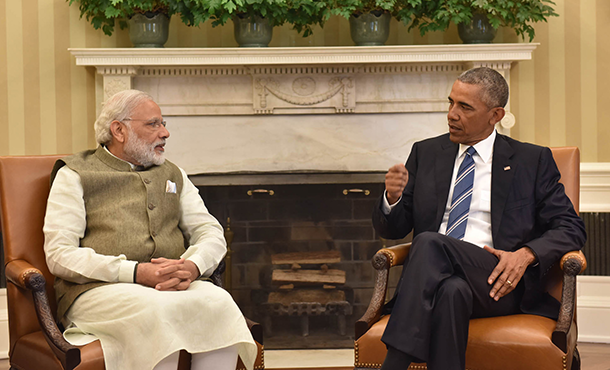
Indian Prime Minister Narendra Modi meeting with President Obama at the White House (Photo: US Embassy New Delhi)
CURWOOD: Let's was talk about some of things that they put on the table to electrify India. I mean, India has a lot a coal, so what did they talk about in terms of clean energy?
POPE: Well, they agreed to create two new financing facilities because the barrier to clean energy is not that it's expensive. It's actually cheaper over its lifetime than coal or anything else, but to get it done you have to finance it. You have to have the upfront money because when you put up a solar panel, you're buying 20 years of electricity at once, because after that it's free. Finance is a problem in India. It's a high interest rate economy. It's got limited capital markets. Finance is not a problem in United States. We have an abundance of capital sitting on the sidelines and low interest rates. So what Modi and Obama agreed to was to set up two financing facilities, not to pay for all this electricity but simply to take the risk out of the equation, so that a US Bank or US pension fund can loan for Indian solar for an off-grid village and they won't have to worry about the future price of the rupee. They won't have to worry about some situation, which India defaults on its loans. Those would be guaranteed by the US government and the projects would be prepared and vetted by US philanthropy funded NGOs. So it's a partnership for the first time between American NGO finances, the Indian government and the government of the US.
CURWOOD: Now, what about the interest rate problem, Carl, because you know companies borrowing here, they can get money four, five, six, percent, over there, you know, 12, 13, 14, 15 percent.
POPE: Well, the idea is they would loan into India, pay for Indian solar and get nine percent. The Indians are happy because it's a lot cheaper than 14, the American banks are happy because it's a lot better than four.
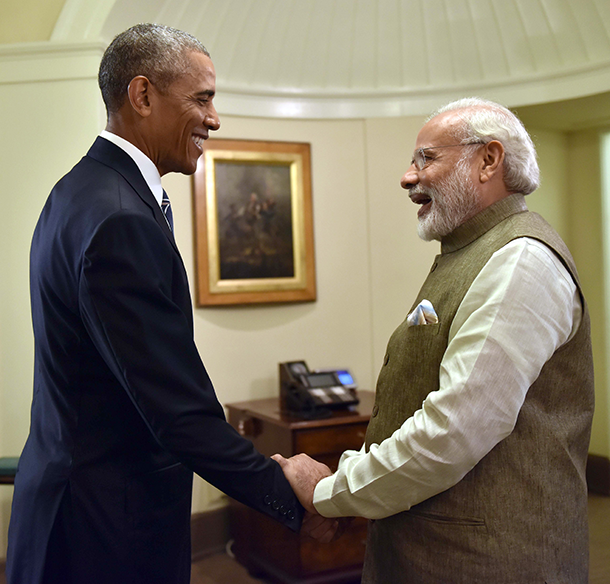
Prime Minister Modi and President Obama (Photo: US Embassy New Delhi)
CURWOOD: How much investment are we going to see here, and how big is it in terms of the need, do you think?
POPE: The two facilities that were announced last week are probably going to leverage a billion dollars of private investment even though there's only $60 million of government money and foundation money involved.
CURWOOD: And how far does $1 billion go in terms of solarizing India?
POPE: A billion dollars, because you turn it into a revolving fund, a billion dollars will probably give a hundred million people electricity. It's really not that expensive to give people electricity, it's just that you need to finance it. You need the money up front.
CURWOOD: That's amazing that a hundred million people will be able to get electricity with this deal.
POPE: It's a huge deal, and once we do that, frankly, the market will then have developed, the supply chains will be built out, and we think the rest of the job will get done. Because I think we actually can say with these facilities that India is well on the path to universal electrification, something it's been seeking for 40 years.
CURWOOD: Now, what about the United States and the WTO? I mean right now US has a decision from the WTO that essentially blocks India from supporting local solar power generation with a subsidy. And India said look we would have this subsidize solar for things like the national rail system.
POPE: I think that is one of the stupidest things the US government has ever done. Most people in the US government think it was one of the stupidest things the US government as ever done.
CURWOOD: So, why is it still there?
POPE: Because the US trade representative's office wants to demonstrate to some US companies that they're tough guys.
CURWOOD: So, wait a second. We have the President of the United States, the Prime Minister of India coming together, a little singing kumbaya to do solar and yet the US trade organization, the trade ministry, if you want to use that word, has got India on the ropes in terms of subsidizing local solar. The president has no power here I gather.
POPE: I mean, the US trade office often does this. They go off and they say the most important thing in the world is the fine print in the WTO, the most important thing the world is not the policy the President of United States. That's not uncommon and this is one place where I think Barack Obama needs to use his pen to give instructions to his trade rep.
CURWOOD: A little more on India. I understand that there's also an agreement dealing with HFCs, the refrigerant chemicals.
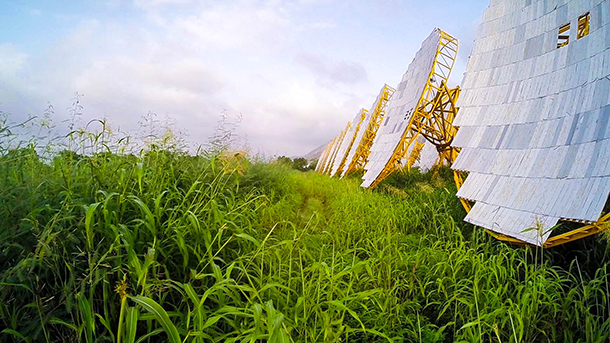
A solar thermal array in India (Photo: Brahma Kumaris, Flickr CC BY-NC 2.0)
POPE: For global climate that's probably the big deal. That by itself is worth a half degree in terms of the amount of warming we will experience over the course of this century, and because the HFC's last so long that's actually a half degree 200 years from now. It's a really big deal and getting India on board was the last step and the deal on solar, the US showing the government of India that we were willing to respond to India's needs was a key ingredient in getting India to say,“OK, we'll get behind a rapid phase out of HFCs.”India had wanted a slower phase out again because they have some domestic companies that like the US solar companies pushing the trade office Modi had some domestic HFC companies pushing him and it was really terrific that they got over that hurdle.
CURWOOD: So, perhaps you could give us a little status update on renewables more generally. I mean over the years a lot of has been made about the expense of green energy compared to fossil fuels. It seems that the formula is flipping or do I have wrong?
POPE: The formula has flipped. The answer for electricity is that in most markets in most of the world you could now deploy wind and solar more cheaply than any other form of new generation, and fairly shortly it's going to be true in many of those countries that new solar and wind will be cheaper than already constructed coal and nuclear.
CURWOOD: In your view, what is driving the declining cost of renewables?
POPE: Deployment. Deployment. Deployment. It's called economies of scale. It's not a new idea. Adam Smith pointed it out back in 1776 when he published Wealth of Nations. The more you put in new technology out in the marketplace the cheaper it gets. And this turns out to be particularly true with technologies that have a lot of information embedded in them, like computers and solar panels and wind turbines, and the price of solar panels has just been plummeting, and I saw an article yesterday saying it's probably going to plummet another 50 percent.
Let me put that in context. Last month in Dubai, a solar project, unsubsidized, was contracted at three cents a kilowatt-hour. If that price drops 50 percent in the next five years that means that by 2020 solar will cost one and a half cents a kilowatt-hour. That is the cheapest electricity in world history. Not just the cheapest electricity today. The cheapest electricity anybody has ever had.
CURWOOD: A lot of people are going to love it. I think a number of folks that have a different attitude are going to be upset that you can't put a meter on the sun, can you?
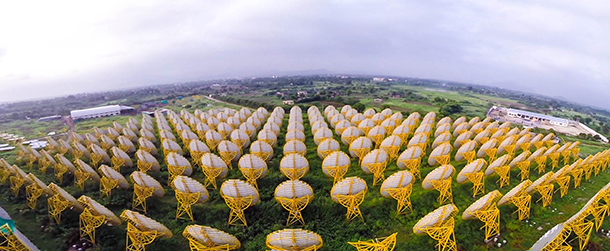
Over the long term, solar is a relatively low-cost form of energy, but installations carry a significant up-front cost and require financing. (Photo: Brahma Kumaris, Flickr CC BY-NC 2.0)
POPE: You can't put a meter on the sun. That is true.
I want to say one thing about the Indian situation. One of the striking things is that the government of India recognizes the danger that they are going to have power plants that are stranded assets and just last week, just after the Modi-Obama meeting, the government of India canceled four of their largest coal-fired power projects. They just canceled them they said, “we don't need them,”and they said, in fact, “we don't need a new coal-fired power plant for the next three years. We can have a pause on building coal until we see what we really need.”And my guess is that pause may effectively be close to permanent. They will only build coal plants going forward to replace with new modern plants old ones they need to shut down. I think we may have seen peak generation from coal-fired power in India.
CURWOOD: So, Carl, to get to a 100 percent renewable future, what do we need in terms of totally new technologies, or do you feel we're really good to go with just more efficiencies with solar, wind, tidal, so and so forth.
POPE: I don't think on the electricity front we need anything totally new. We need to do something in United States that other countries in Latin America and China are doing, which is to build long-distance direct-current transmission, so that when the wind is blowing in North Dakota, and it's nighttime in Los Angeles, LA can get its power from the wind. And in Chicago, when the peak load hits at about five to about seven p.m. central time, that's not a very good time for solar power in Illinois, but that is a terrific time for solar power on the west coast and we can shuttle those electrons and the cost, it turns out, is very, very minor. You could cut our electric bills nationally by about 10 percent, by building a national grid. The problem is we have a lot of regulatory barriers, a lot of states that don't want to let people use their territory to ship electrons across them and we're going to have to fix that problem.
CURWOOD: Carl, before you go, tell me why so many wealthy countries are seemingly reluctant to invest in renewable power for the developing world? It is one planet; it is one atmosphere; it is one catastrophe of climate disruption we face if we don't work together.
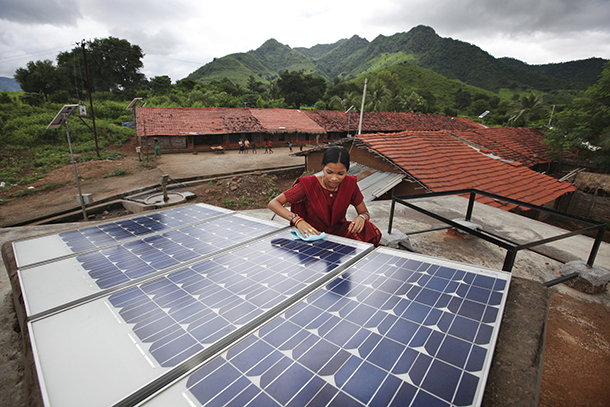
Rural solar panel maintenance does not add significantly to the total cost of solar energy (Photo: UK Department for International Development, CC BY-NC-ND 2.0)
POPE: We in the industrial world have been telling ourselves a lie for the last five years. The lie is that we're overleveraged; the lie is that we have overinvested. We don't just tell us this lie about whether we can afford to invest in clean energy in Africa. We tell us this lie, that way we can afford to repair bridges in Milwaukee, and the Europeans tell themselves this lie about whether they can afford to modernize their grid in Europe. So austerity, the idea that the problem the rich world faces is we have invested too much, has got our hands tied behind our back, and so we're not doing a whole bunch of sensible things, and then we look around we say,“well, we're not investing. Gee, we're puzzled by why there isn't much job growth. Gee, we're puzzled why the global economy isn't growing. Gee, we're puzzled by why wages aren't rising.”Well, they're not rising for a very simple reason which John Maynard Keynes in the Great Depression: if you don't invest enough, you don't have a dynamic economy, and we need to let go of the bugaboo and austerity and recognize that right now with interest rates in Japan, Europe and United States at record low levels, it's the perfect time to invest in long-range projects like clean energy, like electric cars, like a modern grid and, yes, like bridges in Milwaukee that won't fall into a river.
CURWOOD: Why do you think the rich part of the world has a poverty mentality?
POPE: Because we have a political movement in the global north, which believes that government is a problem and collective resources are a curse, and that everything should be privatized. So they have told us over and over and over again that we're poor and that we need to cut back and that the big problem is the national deficit. Well, the national deficit is a big problem if we acumulate it by wasting it on things like wars. The national debt is not a big problem if we just invested in things that make the economy grow faster.

Carl Pope is the former Executive Director of the Sierra Club and advisor to Inside Straight Strategies. (Photo: EcoWatch)
CURWOOD: So right now, interest rates are low. We are seeing more and more climate related disasters and warfare doesn't seem to be declining right now. What if interest rates start to go up?
POPE: Well, interest rates will start to go up but it's not just interest rates. Right now the world is awash in a glut of the things you need to invest. The world is awash in steel. The world is awash in cement. The world is awash in copper. The world is awash in cheap money. This is a perfect time to begin building the hundreds of trillions of dollars of infrastructure that the world is going to need between now and 2050 to accommodate the reality that we're going to have several billion new consumers in the global economy between now and 2050, and they're going to need stuff that we haven't built. Seventy percent of the buildings that will be in India in 2050 have not yet been built. So this is not only the perfect time not only to do it cheaply, but to do it right.
CURWOOD: Carl Pope is former Executive Director of the Sierra Club and now adviser to Michael Bloomberg who is the special envoy for United Nations on Climate Change. Thanks a lot for taking the time.
POPE: Thank you. It was great being with you again, Steve.
Links
Read Carl Pope’s article in EcoWatch
Read more about India’s agreement to phase out HFCs
White House statement on the joint agreement between the U.S. and India
Living on Earth wants to hear from you!
Living on Earth
62 Calef Highway, Suite 212
Lee, NH 03861
Telephone: 617-287-4121
E-mail: comments@loe.org
Newsletter [Click here]
Donate to Living on Earth!
Living on Earth is an independent media program and relies entirely on contributions from listeners and institutions supporting public service. Please donate now to preserve an independent environmental voice.
NewsletterLiving on Earth offers a weekly delivery of the show's rundown to your mailbox. Sign up for our newsletter today!
 Sailors For The Sea: Be the change you want to sea.
Sailors For The Sea: Be the change you want to sea.
 The Grantham Foundation for the Protection of the Environment: Committed to protecting and improving the health of the global environment.
The Grantham Foundation for the Protection of the Environment: Committed to protecting and improving the health of the global environment.
 Contribute to Living on Earth and receive, as our gift to you, an archival print of one of Mark Seth Lender's extraordinary wildlife photographs. Follow the link to see Mark's current collection of photographs.
Contribute to Living on Earth and receive, as our gift to you, an archival print of one of Mark Seth Lender's extraordinary wildlife photographs. Follow the link to see Mark's current collection of photographs.
 Buy a signed copy of Mark Seth Lender's book Smeagull the Seagull & support Living on Earth
Buy a signed copy of Mark Seth Lender's book Smeagull the Seagull & support Living on Earth

